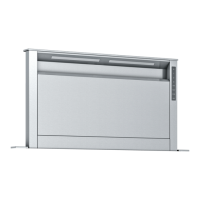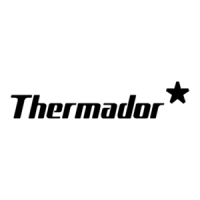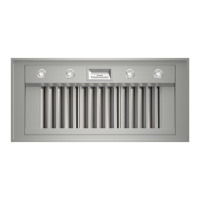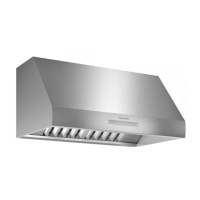Page 6
TABLE 2. DUCT WORK INSTALLATION GUIDELINES
• Keep duct runs as short and straight as possible.
• Duct fittings (elbows and transitions) reduce air flow
efficiency.
• Back to back elbows and "S" turns significantly re-
duces air flow and are not recommended.
• A short straight length of duct at the inlet of the remote
blower gives the best delivery.
• Transition to round duct as close to the Cook‘n’Vent®
as possible. In order of preference, use
1st. 10" round duct
2nd. 8" round duct
3rd. 7" round duct
4th. 3-1/4" x 14" duct
5th. 3-1/4" x l0" duct
6th. 6" round duct
• The use of flexible metal round duct should only be
used when no other duct fitting exists. Limit use to
short lengths and do not crush when making corners.
• Where local codes permit, plastic pipe (PVC-schedule
40 pipe or ABS pipe 7" or 8" diameter) can be used in
areas of high ground moisture and in slab floors to
eliminate future rusting.
• Use only duct work constructed of materials that are
acceptable by the applicable codes. All duct should be
26 gauge or heavier to minimize flex due to air flow.
• The remote blower requires a 10" diameter round duct
to match the inlet ring, so a transition to a 10" diameter
is necessary from other duct sizes.
• Use sheet metal screws as required to support the duct
weight, and seal all joints with duct tape.
• Be certain that the duct work does not interfere with
floor joists or wall studs.
• Do not exhaust more than one vent into a single duct
run.
• Thermal breaks, such as a short section of nonmetallic
duct, should be used in areas of extreme cold.
• Always use an appropriate roof or wall-cap with
damper. Laundry type wall caps should
never be used.
For installation of the Cook'n'Vent
®
with a Thermador
cooktop, refer to Part A and Figure 7. For installation with
another brand of cooktop, refer to Part B and Figure 8.
For all installations, verify cutouts will clear the inside of the
front countertop support rail. (See cutout depth in Figure 2).
The front and rear cutouts must be straight and parallel to the
front edge of countertop and the rear backsplash or wall.
Assure that the side cutouts are square to the front and rear
cutouts. All illustrations and dimensions are based upon
standard 24" deep by 36" high American style base cabinets
with 25" countertops.
When installing laminated or solid surface countertops such
as Surell™ and Corian
®
,
be sure to follow the countertop
manufacturer's instructions regarding minimum corner ra-
dii, reinforcement of corners, etc.
For overhead cabinet and cooktop side clearances consult
cooktop Installation Instructions.
STEP 2
PREPARE COUNTERTOP CUTOUT
A. INSTALLATION WITH A
THERMADOR COOKTOP
(FIGURE 7 AND TABLE 3)
Provide an opening in the countertop as specified in
Table 3. Make sure the distance from the front of the
countertop to the front of the cutout is not less than dimension
"SB." Verify that the available flat countertop is greater than
dimensions "OW" by "OD." Make certain the backsplash
thickness does not exceed dimension "BT".

